Text
AAH Conference 2024
I will be presenting a paper on the talismanic qualities of early print as part of the panel "Embodied Experience in the Early Modern World" at the Association for Art History conference this coming April.
https://forarthistory.org.uk/embodied-experience-in-the-early-modern-world/
4 notes
·
View notes
Text
Notes on women in early printmaking
While in Baltimore for the SCSC this year I attended a panel related to the exhibition Making Her Mark – A History of Women Artists in Europe 1400-1800 at the Baltimore Museum of Art. As part of this, the methodological approaches the curators took towards the attempted identification of female artists amongst the various anonymous objects within museum collections was discussed.
This, apart from being interesting in its own right, sparked something relating to an ongoing conversation I had been having with several other conference attendees about who were all these anonymous formschneider (cutters of the wood blocks for relief print illustrations) who made the images that we were considering. I asked the exhibitions curator, Theresa Kutasz Christensen, about this and she said absolutely, women were involved in the early print industry and there was an essay in the catalogue on this subject.

Yolanda Bonhomme, Extravagantes viginti Joannis Vigesimissecundi…, Paris, 1549.
I fortunately had time to see the exhibition – which was excellent – and get a copy of the catalogue. The essay, by Madeleine C. Viljoen, focused mainly on later intaglio printing in Italy but did highlight the work of the nuns at the convent of San Jacapo di Ripoli in Florence in the late fifteenth century – who I was aware of from their brief employment of Niccolò di Lorenzo in 1480 – and the amazing work of Yolande Bonhomme in Paris in the sixteenth. Bonhomme, from a printing family, ran the press at the sign of the Unicorn and was the first documented woman to print publish an edition of the Bible (in Latin) in 1526. This, while all interesting background stuff, did not really help with the discussion on woodblock printing in the German speaking lands that are my particular focus.
Another essay in the catalogue, on the printing of textile patterns, by Alexa Greist did however have some useful information on the activities of the Augsburg printer Johann Schönsperger the younger who took over his father’s press in ca.1521. Most of the output from this press I am aware of relates, naturally, to radical political and religious pamphlets and merges with the work of Jörg Gastel who appears to have taken many of Schönsperger’s blocks to Zwickau in 1523-4. Following this, between 1525 and 1529 Schönsperger published A New Book of Forms – one of the first commercial pattern books for lace and embroidery.
This work, intended for the emerging “feminine” trades of textile production (see Sebald Beham’s The Spinning Bee, ca.1524), does not necessarily prove the involvement of female labour the workshops of Schönsperger and Gastel at this time. But, taken with the wider discussion on the topic from Viljoen and Kutasz Christensen, can be at the very least be used to demonstrate its possibility. This connection between the radical printers of pamphlets of the “common man” and the female worker gives an important reminder that the assumptions around gender so commonly made about the early history of printing are precisely that – assumptions.
***
Primary sources:
Sebald Beham, Spinning Bee, ca. 1524, Ashmolean Museum of Art and Archaeology, Oxford.
Yolanda Bonhomme, Extravagantes viginti Joannis Vigesimissecundi…, Paris, 1549. Collection of Lisa Unger Baskin. (Author’s photograph.)
Johann Shönsperger the Younger, Ein ney Furmbüchlein, Augsburg, ca.1525-9. The Metropolitan Museum New York, 18.66.1(1-33). (Available at: https://www.metmuseum.org/art/collection/search/354716)
Secondary sources:
Böninger, L., 2021, Niccolò di Lorenzo della Magna and the Social World of Florentine Printing, ca. 1470-1493, Cambridge: Harvard University Press.
Greist, A., 2023, “Prints and Needles: Women Makers and European Textile Pattern Books”, in A.B. Banta, A. Greist and T. Kutasz Christensen (eds.), Making Her Mark – A History of Women Artists in Europe 1400-1800, Fredericton: Goose Lane. 30-41.
Kutasz Christensen, T., 2023, “Too Good to be by a Woman: Locating Pre-Modern Women Makers in Museum Collections” SCSC, Baltimore, MD.
Stewart, A., 2003, “Distaffs and Spindles: Sexual Misbehavior in Sebald Beham’s Spinning Bee”, Faculty Publications and Creative Activity, School of Art, Art History and Design, University of Nebraska – Lincoln. 4. (Available at: https://digitalcommons.unl.edu/artfacpub/4)
Viljoen, M.C., 2023, “Multiple Challenges or the Challenge of Multiples: Early Modern Women as the Creators of Prints”, in A.B. Banta, A. Greist and T. Kutasz Christensen (eds.), Making Her Mark – A History of Women Artists in Europe 1400-1800, Fredericton: Goose Lane. 58-75.
2 notes
·
View notes
Text

I will be in Baltimore next week week presenting my paper “A peasant and a knight have risen in response”: An Examination of the Frontispiece of Melchior Ramminger’s Pamphlet Commenting on the Diet of Worms at the Sixteen Century Society Conference 2023. Here is some early fluted ‘Maximilian’ three-quarter length field armour, (c. 1505 - 1515) from one of the slides.
0 notes
Text
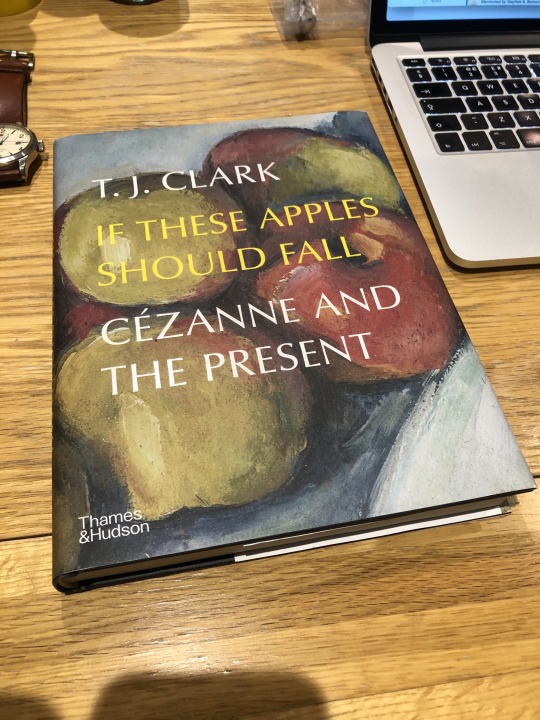
Another new book - not for reviewing, but got because I am a big fan of Clark and he discusses Cézanne's depictions of "peasants" in it.
1 note
·
View note
Text


Jamie Dyson and I will be showing two films - The Devil Moves in Straight Lines (2023) and After the Rain (2022) - at The Moving Gallery, Sunderland (SR1 1RE) from 15-25th September.
As part of What does life after death look like? curated by the amazing and multi-talented Amy South. See: https://amysouth.co.uk/ for more details of the show.
0 notes
Text

Quite excited about this book that just arrived for me to review for the Austrian History Yearbook
1 note
·
View note
Text
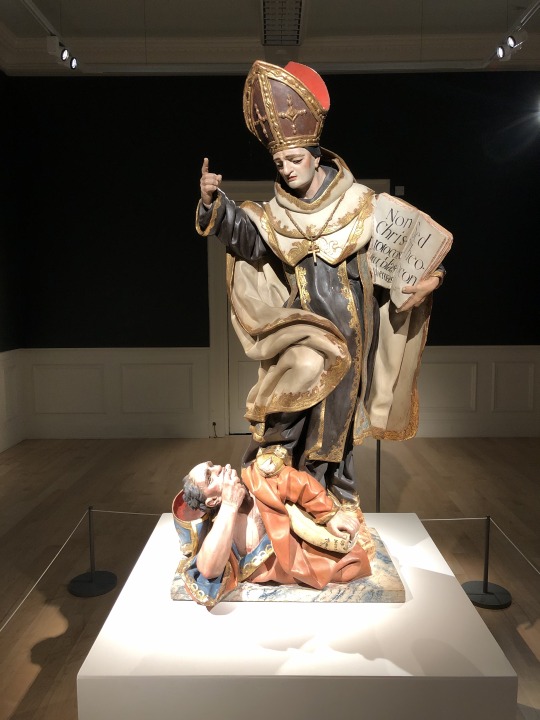

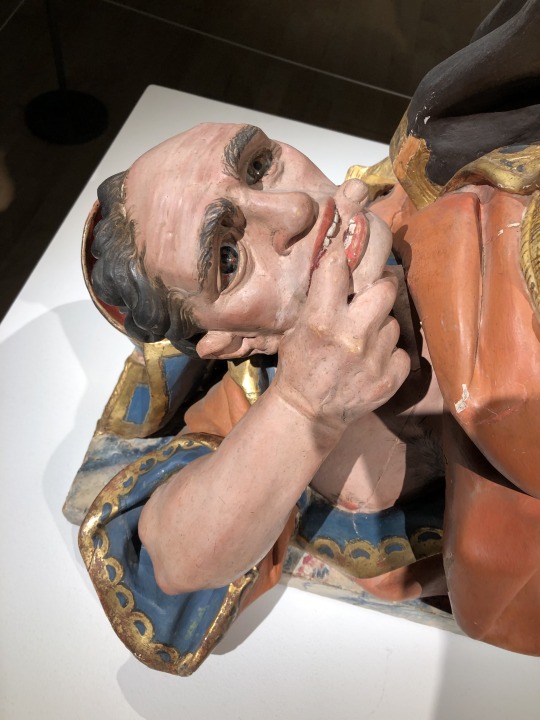
St Cyril of Alexandria triumphs over Nestorius, Spanish(?) ca.1680
I saw this new acquisition in the New Walk museum in Leicester last week when we went to see my Mum. Cyril here is the representative of orthodox Christianity triumphing over the heterodox Nestorius, who gave his name to the Nestorian church, at the Council of Ephesus (431CE). The doctrinal dispute was over the nature of Mary as “mother of God”, but the real core of the issue was more to do with a political power struggle between the bishoprics of Constantinople (Nestorius’ See) and Alexandria, and combating Nestorius’ broad approach to issues of dogma and conciliatory position towards Jews and pagans.
7 notes
·
View notes
Text

Taking a break from the writing and doing some work on a video - I shot the original footage in 2017 but wasn't sure how to develop it as a project so it stayed waiting.
Finding the time to actually make art is very hard with all the other pressures on life right now - but it is good to try from time to time.
2 notes
·
View notes
Text
"The Sword in the Ragged Sheath..."
I am pleased that I am able share the submitted draft (complete with typos) of my book chapter - meaning that anyone who is interested in the text, but unable to pass the gatekeepers of the ivory tower of academia can read it!
2 notes
·
View notes
Text
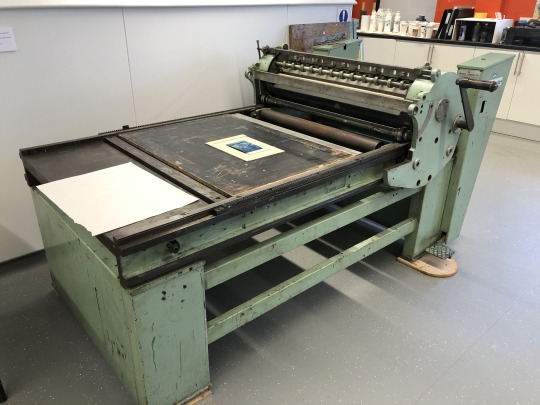
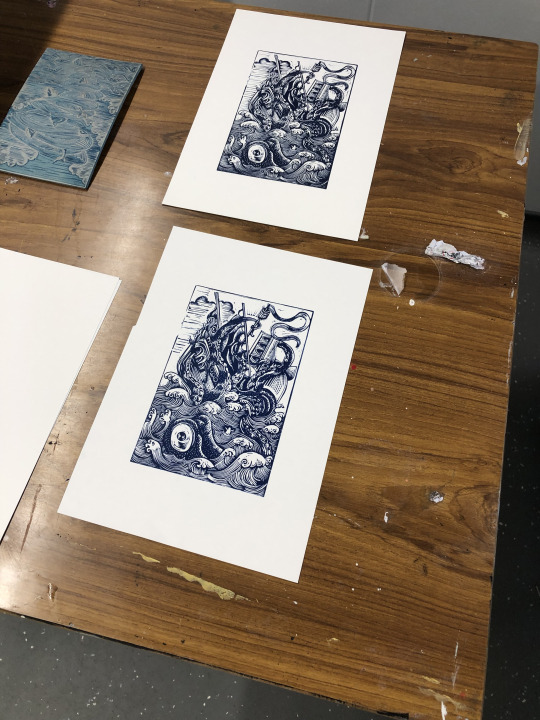
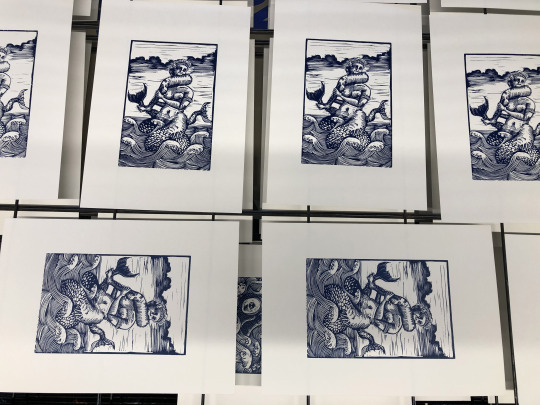

Printing - or re-printing - a series of images. This is the first time I have been able to get any done since the pandemic (and the birth of my son). I was up at the print room at Solent University - they have a really nice counterslip press and I was able to get over 40 clean images in the day despite being out of practice!

1 note
·
View note
Text
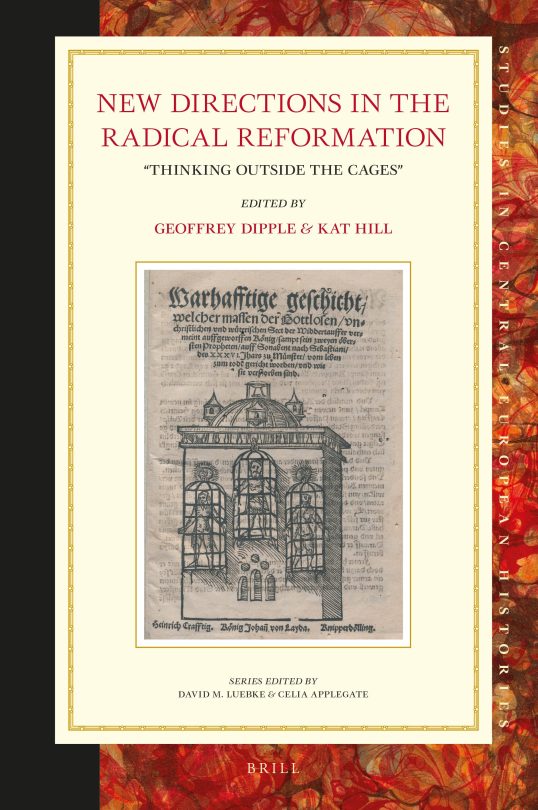
My book chapter is finally published!
The book is currently available in hardback but as an ebook any day now - https://brill.com/display/title/64874
Jonathan Trayner – The sword in the ragged sheath; the motif of the peasant radical in sixteenth-century prints
Abstract: This chapter outlines and explores the connections between various prints from the long sixteenth century that used the motif of the peasant carrying a sword in a ragged sheath. Beginning with Schongauer’s Peasant Family Going to Market (1470-5), the motif is traced through the various re-purposings of Schöffer’s peasant figures from his Frankfurter Messeflugblatt (1516), including its use on copies of The Sermon of the Peasant of Wörhd and The Twelve Articles (1520s), the prints of Sebald Beham and Erhard Schön, and the paintings of Hans Wertinger and Bruegel; up until its use on the banner of the Basel peasants of 1653. Connections and relationships between those prints and paintings considered to have art historical merit and less celebrated and ephemeral works are drawn out. The narrative and symbolic meanings of the motif is considered alongside its interpretation by both the urban elites for whom the majority of these works were made, and the peasants who were the subject of these images. The argument being that, with their use and reappropriation of these images in various contexts, the peasants demonstrated a more sophisticated political use of visual symbolism than they are usually considered to possess.
0 notes
Text

while looking for something else i came across this image of the crucifixion from a 7th century coptic magico-religious text. more information on its meaning can be found here: https://www.coptic-magic.phil.uni-wuerzburg.de/index.php/2019/04/26/jesus-and-the-unicorn-easter-and-the-harrowing-of-hell-in-coptic-magic/
1 note
·
View note
Text
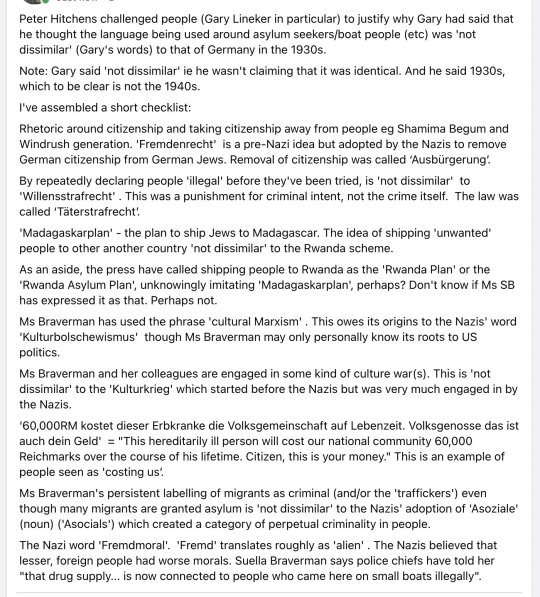
Why do you find the need to use that kind of language? Gary Lineker and disallowed speech
On the 13th of January 2023, Joan Salter stood up in a public meeting in Suella Braverman’s constituency and said:
I am a child survivor of the Holocaust. In 1943, I was forced to flee my birthplace in Belgium and went across war-torn Europe and dangerous seas until I finally was able to come to the UK in 1947. When I hear you using words against refugees like ‘swarms’ and an ‘invasion’, I am reminded of the language used to dehumanise and justify the murder of my family and millions of others.
Why do you find the need to use that kind of language?
Braverman batted away the question with the usual obfuscations, it was reported widely in the national news and disappeared after a couple of days.
On the 7th March, former England footballer Gary Lineker, replied to a comment on his Twitter feed discussing the same subject with the following:
There is no huge influx. We take far fewer refugees than other major European countries. This is just an immeasurably cruel policy directed at the most vulnerable people in language that is not dissimilar to that used by Germany in the 30s, and I’m out of order?
As a result, Lineker was “stepped back” from presenting Match of the Day, his fellow presenters refused to appear on the show, and a huge row ensued in which the notions of impartiality in public service broadcasting were extensively discussed. The meanings and implications of this were generally well analysed by Barney Ronay in the Guardian. However, after the event, one paragraph of Ronay’s stands out:
Lineker’s key mistake was to throw Nazi Germany in there. However fine and nuanced his understanding of the semiotics of National Socialist messaging in the years 1930-1940, it would be good generally if people could stop using Nazi Germany as a kind of bad things emoji. Better to explain and use detail. Save Nazi Germany. Keep it in your back pocket for those occasions when only Nazi Germany will do. In doing so he offered up an opportunity. And an opportunist will never miss one of those.
This became one of the ways the outraged right were able to attack Lineker, his comments were excessive, out of order, disrespectful to the victims of the Holocaust, etc. This was something about which he was not qualified to speak. He should stick to his job, to football. Such replies are common currency in our current social and political discourse – everyone has the right to speak but some people’s speech is disallowed.
There are those who are expected to speak – politicians, journalists, academics, they are (apparent) experts, and their job is to have an opinion, and their right to speak is not questioned. Then there are those with lived experience, such as Joan Salter. No one questioned her right to make the comparison between the rhetoric of National Socialist Germany in the 1930s and that of the current British government. Suella Braverman did not tell her that that she was “offended” by the comparison because her husband is Jewish. The speech of these two groups is allowed.
Then there is the vox populi, all (non-theocratic) political discourse pays lip service to the idea that the public are the supreme arbiters of right. However, the public can speak but only anonymously and en masse – as the voice of the people. This is ideally filtered through an allowed source, a community leader, a union, a consultation, an opinion poll. If this doesn’t happen, then they can be categorised as the mob. But there is never a shortage of people who claim to speak for the people, or at least the right-thinking people, or the ordinary hardworking people, or to provide the voice of common-sense. And if the public do not speak in the approved manner, you can always “dissolve the people, and elect another”.
The public figure – the sportsperson, the musician, etc. – speaking outside of their role is disallowed, because they are neither expected to speak, nor anonymous. Here we have someone who has the views of an ordinary person, right or wrong, but whose public visibility is not predicated on those views but rather on their talents in another field. They are, as Lineker – as the son of a market trader from Leicester – is, often the wrong class, and went to the wrong school. Perhaps however, the key point is that their participation is voluntary– they are not obligated to speak by either their profession or their lived experience. Indeed, quite often it would be better for them professionally not to have done so. No one requires Lineker’s opinion of the government’s cruelties, he is only speaking out because he feels it to be right. Most ordinary people could not speak in the way that Lineker did, with the risk of losing their job, simply because they cannot afford to do so. The already public figure in this sense has two privileges on their speech – visibility and lack of (serious) consequences, so it is vital that speech is disallowed.
In this instance the correctness of Lineker’s statement is irrelevant, Salter can make the same point, and Michael Rosen can (on 15th March) offer a series of concrete examples of the corelations between the language of the National Socialists of the 1930s and our government. Such recourse to facts, that demonstrate that our government is deliberately deploying the same rhetoric as the Nazis, is irrelevant in the current discourse and only proves how out of touch with ordinary people, we, the experts, are. This is because we are operating in a political landscape where speech is gestural and as Walter Benjamin pointed out (in the 1930s) politics is aestheticised. Slogans such as “Stop the boats” – are vague and meaningless except as a threat. There is no functional plan behind this intention, it will not work, but that does not matter because some other group can be blamed for its failure. This is the whole purpose behind policies of this sort, to provide a performative space for futile discussion while the real “criminals” on boats – the superyacht owning asset strippers who are the beneficiaries of current government policy – continue their work.
***
Barney Ronay, The Guardian, 10/03/23 –
Walter Benjamin, Work of Art in the Age of Mechanical Reproduction, 1936 – https://www.marxists.org/reference/subject/philosophy/works/ge/benjamin.htm
Suella Braverman, The Independent, 09/03/23 –
Berhold Brecht, Die Lösung (The Solution), 1953 – https://mronline.org/2006/08/14/brecht140806-html/
Gary Lineker, Twitter, 07/03/23 –

Michael Rosen, Twitter, 15/03/23 – https://twitter.com/MichaelRosenYes/status/1635918291385430020
Joan Salter, The Guardian, 14/01/23 –
0 notes
Text

working on the final proofs for my forthcoming book chapter: https://brill.com/display/title/64874
0 notes
Photo

Book that I am currently reviewing for the SCJ - there is some really interesting stuff in it about how woolen cloth - panni di garbo - was used as credit guarentee by printers in northern Italian in the 16th century. Because payments for finished cloth with in the wool trade were traditionally deferred they would “buy” the cloth, sell it on, and in theory pay on the due date - either in cash or books. The print trade being uncertain this was seen as more legally binding than an agreement to deliver books later to an investor or other credit forms.
0 notes
Photo
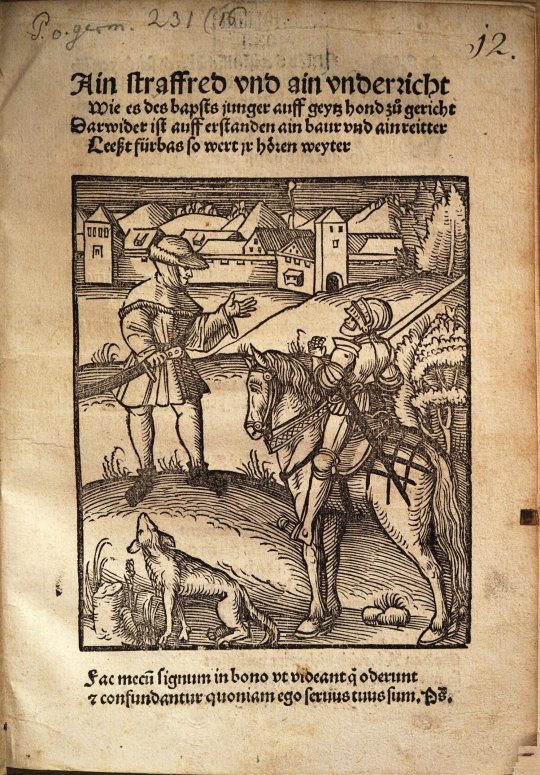
I will be presenting on this image as part of the Conflicts, Disputes and Protest in Pre-Modern Print and Visual Culture session at the AAH conference 2023 - see https://forarthistory.org.uk/conflicts-disputes-and-protest-in-pre-modern-print-and-visual-culture/ for more details.
0 notes
Link
A new film by Jamie Dyson and I will be discussed by the Art, Environment and Social Change research group at Southhampton Solent University on the 7th Nov - and online if you want to drop in
0 notes